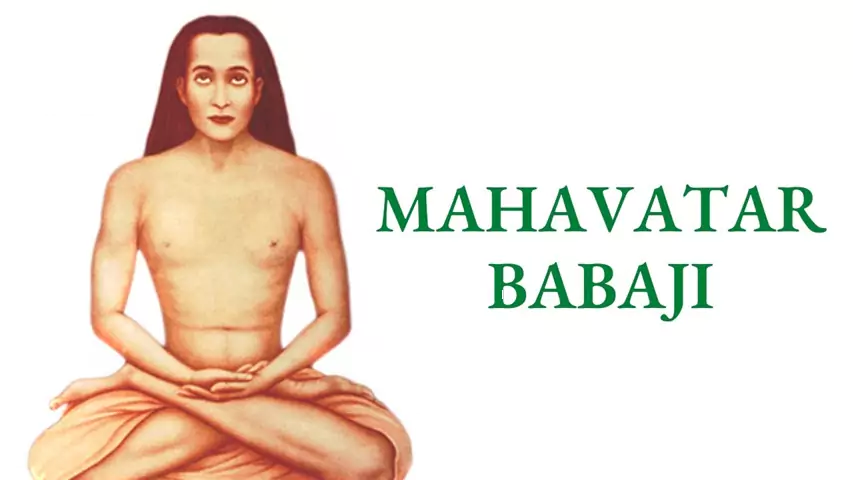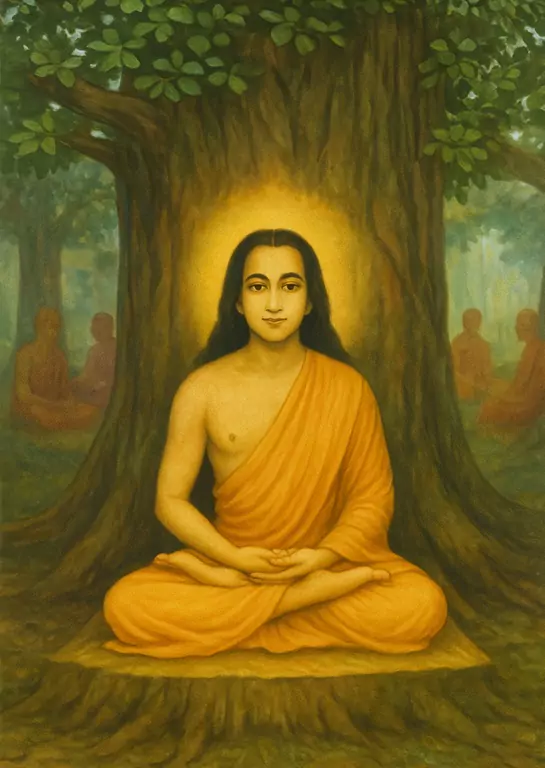- April 1, 2025

In 1946, one of India’s most celebrated yogis, Paramahamsa Yogananda, unveiled the existence of a Christ-like, immortal master named Mahavatar Babaji in his timeless classic, “Autobiography of a Yogi.” Yogananda revealed how Babaji, from his remote Himalayan abode, silently guided numerous spiritual masters without their knowledge. Babaji is a great Siddha, a master who has transcended human limitations and works tirelessly behind the scenes for the spiritual evolution of humanity.
Yogananda further disclosed that it was Babaji who, in 1861, initiated Lahiri Mahasaya into the powerful techniques of Kriya Yoga. Lahiri Mahasaya, in turn, passed on these sacred teachings to many disciples, including Yogananda’s own guru, Sri Yukteswar.
After Yogananda had spent 10 years with his master, Babaji appeared before him, commanding him to travel to the West and spread the holy science of Kriya Yoga. Yogananda successfully fulfilled this divine mission from 1920 until 1952, when he entered Mahasamadhi, consciously leaving his physical body. The profound power of Kriya Yoga and the blessings of his masters were evident: Yogananda’s body remained in a pristine, undecayed state for 21 days after his passing, until it was interred in a crypt. On March 7, 2002, the 50th anniversary of his Mahasamadhi, his body was transferred to its final resting place. Today, thousands worldwide continue to cherish the spiritual legacy he left behind.
Beginning in 1942, Babaji began preparing two souls in South India—S.A.A. Ramaiah and V.T. Neelakantan—to spread Kriya Yoga. S.A.A. Ramaiah was a young geology student at the University of Madras, while V.T. Neelakantan was a renowned journalist, a close student of Annie Besant, and a consultant to J. Krishnamurti. Babaji appeared to each of them separately before uniting them for his divine work.
Between 1952 and 1953, Babaji dictated three books to V.T. Neelakantan: “The Voice and Intuition of Babaji,” “Babaji’s Cure for All Diseases,” and “The Death of Death – Babaji.” In these writings, Babaji revealed his own life, lineage, and the profound science of Kriya Yoga.
Following Babaji’s wishes, on October 17, 1952, V.T. Neelakantan and S.A.A. Ramaiah established the “Kriya Babaji Sangam” to propagate his Kriya Yoga. The publication and distribution of these books caused a sensation in India. An attempt by the SRF organization to suppress the books and the Sangam was thwarted by the timely intervention of Pandit Jawaharlal Nehru, then Prime Minister of India and a friend of V.T. Neelakantan. In 2003, the Babaji’s Kriya Yoga Trust re-published all three books as a single volume titled “The Voice of Babaji.”
In “Babaji’s Cure for All Diseases,” Babaji answers the question, “Who am I?” In truth, we discover who Babaji is when we truly realize who we are. Babaji does not identify himself with a personal identity, a collection of life events, or even his divinely transformed “Shuddha” body. However, in his book, he revealed certain details of his life to provide a path for our own spiritual awakening. These details are compiled in the book “Babaji and the 18 Siddha Kriya Yoga Tradition.”
Babaji was named “Nagaraj,” which means “King of Serpents,” symbolizing the immense divine power within us. He was born on November 30, 203 AD, in the coastal village of Parangipettai in Tamil Nadu, on the auspicious Rohini star—the same star as Lord Krishna—during the festival of Karthika Deepam. His parents were Nambudiri Brahmins who had migrated from the Malabar region. His father served as a priest at a Shiva temple, which is now dedicated to Lord Murugan.
At the age of five, Nagaraj was kidnapped by a merchant and taken to what is now Kolkata, where he was sold into slavery. A wealthy merchant later purchased him and, in an act of compassion, set him free. Nagaraj then joined a group of wandering ascetics, mastering sacred religious and philosophical literature. Unfulfilled, he learned of the great Siddha master Agastya, who lived in the South. He embarked on a pilgrimage to the sacred Katirkamam temple in southern Sri Lanka to seek him out. There, he met Bhoganathar, Agastya’s chief disciple, and underwent rigorous meditation and Yogic training. Through this practice, he achieved a state of savikalpa samadhi and was blessed with a vision of Lord Murugan, the presiding deity of Katirkamam.
When Nagaraj turned 15, Bhoganathar sent him to his own guru, Agastya, who lived near Kutralam. After 48 days of intense Yogic practice, Agastya appeared before Nagaraj and initiated him into the powerful Kriya Kundalini Pranayama. Agastya then instructed the young Nagaraj to go to Badrinath in the high Himalayas and intensify his practice to become a true “Siddha.”
For the next 18 months, Nagaraj lived alone in a cave, practicing the Yogic techniques taught by Bhoganathar and Agastya. By surrendering his ego to the divine, he became fully one with God, transforming every cell of his body. He became a complete Siddha, a master of divine consciousness and power, his body forever freed from death and disease. From that moment, Babaji dedicated himself to uplifting suffering humanity.

For centuries, Babaji has guided the divine missions of many historical sages and spiritual masters, including Adi Shankara, who reformed Hinduism in the 9th century, and Kabir, who was revered by both Hindus and Muslims in the 15th century. Both received direct initiation from Babaji and made mention of him in their writings. Babaji is known to maintain the youthful appearance of a 16-year-old. C.W. Leadbeater’s book “Masters and the Path” states that Madam Blavatsky referred to Babaji as “Maitreya,” the “Living Buddha,” or the Guru for the modern age.
While he often prefers to remain unseen, Babaji sometimes appears to his devotees, making a lasting impression on their hearts. Through this, he establishes a devotional relationship with them, guiding them on their spiritual journey. His relationship with each of us is unique, tailored to our needs. He is our personal guru. As our hearts expand, we merge with Babaji through universal love, and we begin to see him in all things.
Babaji revitalized Kriya Yoga as it was described by the Siddha Patanjali in his Yoga Sutras, which were written in the 3rd century. In the first sutra of the second chapter, Patanjali defines Kriya Yoga as consisting of “unwavering non-attachment, self-study, and devotion to God.” Babaji, however, supplemented these with Pranayama, mantras, and tantric techniques to awaken the powerful Kundalini consciousness. Thus, his modern compilation of Kriya Yoga is a comprehensive system of various practices. It was this potent form of Kriya Yoga that he bestowed upon Lahiri Mahasaya in 1861.
In 1954, at his ashram in the Garhwal region near Badrinath, Babaji initiated his devoted disciple S.A.A. Ramaiah into a complete system of 144 Kriya Yoga techniques. These included asanas, breathing exercises (Pranayama), meditation, mantras, and devotional practices. S.A.A. Ramaiah went on to become a great yogi, undertaking the mission of teaching this system, known as “Babaji’s Kriya Yoga,” to thousands of people worldwide.
Fortunately, Babaji occasionally emerges from behind the veil to assist with his divine work. In the 1970s, he appeared to Swami Satyashwarananda in the Kumaon Himalayas and asked him to translate and publish the works of Lahiri Mahasaya. Swami Satyashwarananda published these as a series called “Sanskrit Classics” from his home in San Diego, California.
In October 1999, Babaji appeared to the author of this page, M. Govindan, twice in his pranic body. This occurred 30 kilometers north of Badrinath at an altitude of 5,000 meters, at the source of the Alaknanda River. Babaji appeared as a brilliant youth with copper-colored hair, wearing a white dhoti, and allowed Govindan to touch his feet and receive his blessings.
One cannot truly understand who Babaji is or appreciate his greatness without understanding the Siddha tradition. After realizing their inherent divinity, the Siddhas do not seek to go to some distant heaven. Instead, they completely surrender to that divine consciousness and manifest that state in all dimensions. They undergo a complete transformation of their human nature.
“Thirumantiram,” a collection of 3,000 verses written by the Siddha Tirumoolar between the 2nd and 4th centuries CE, explains the greatness of the Siddhas. Our research suggests that Tirumoolar was a contemporary brother-disciple of Babaji’s guru, Bhoganathar, and of the sage Patanjali, the author of the Yoga Sutras. While much of the Siddha literature has not been translated from Tamil or Sanskrit, the works of Dr. Kamil Zvelebil (“Poets of the Powers”) and Professor David Gordon White (“The Alchemical Body”) offer excellent insights into the Siddhas.
These works thoroughly explain the elevated state attained by the Siddhas, clarifying that Babaji is not some alien being. Babaji embodies the complete manifestation of the next stage of human evolution, the “supra-mental transformation” of human nature that Sri Aurobindo sought for all humanity. He is not a savior, nor is he the founder of a religion. He does not seek our recognition or praise. Like all Siddhas, he is a divine instrument who, by surrendering completely to divine consciousness, brings clear light, infinite joy, and boundless peace to the world. May we all realize the full potential of our humanity.